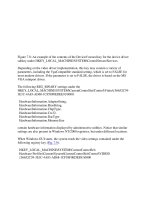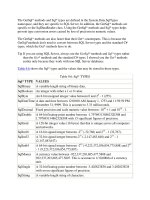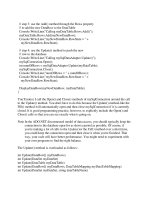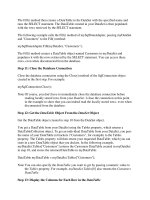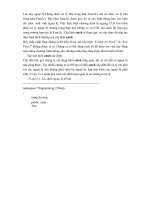Jossey-Bass Teacher - Math Wise Phần 2 docx
Bạn đang xem bản rút gọn của tài liệu. Xem và tải ngay bản đầy đủ của tài liệu tại đây (1.18 MB, 45 trang )
Chapter 9
Celebrate 100 Days
Grades K–8
Ⅺ
× Total group activity
Ⅺ
× Cooperative activity
Ⅺ
× Independent activity
Ⅺ
× Concrete/manipulative activity
Ⅺ
× Visual/pictorial activity
Ⅺ
× Abstract procedure
Why Do It:
Students will increase their comprehension of number and
numeral concepts for the numbers 1 through 100.
You Will Need:
For this ongoing activity, a roll of wide adding-machine paper
tape; marking pens; 100 straws; rubber bands; and cans
with 1, 10, and 100 written on them are needed. For the
culmination activity, a wide variety of items that can be
counted, separated, or marked into 100s will be needed.
(Note: These items should be free or inexpensive, and many
can be brought from home.)
HowToDoIt:
1. Begin the first day of school by taping a long length
of paper tape to the classroom wall (perhaps affixed
just above the chalkboard and spanning the width of
the room). Since this is day 1, write a large numeral 1
at the left end of the tape and tell the students that a
numeral will be added (for example, during the morning
27
opening exercises) for each day they are in school. Continue in this
manner until day 5, at which time note that every fifth number
will be circled. On the tenth day, note that every tenth number
will have a square placed around it, pointing out that 10, 20, 30,
and other 10s numbers have both circles and squares. This ongoing
activity will continue until day 100.
2. Throughout the 100 days, use the cans marked 1, 10, and 100,
along with straws and rubber bands, to help students understand
the 1-to-1 connection with the numerals on the paper tape. On day
1, for example, both write the numeral 1 on the wall chart and
have a student put 1 straw in the 1 can; on day 2, put a 2nd straw
in the can. When day 10 arrives, put a rubber band around the 10
straws that have accumulated in the 1 can and move them to the
10 can, and so on.
3. When the class reaches day 100, it is time for a celebration! On that
day it becomes each student’s responsibility to do, make, count,
separate, mark, or share 100 of something. It will certainly prove
to be a fun learning experience. (See Example 2 and Extension 2
below for some possible ideas for types of 100s.)
Examples:
1. The illustration below shows the numerals on the wall tape and
the straws in the number cans for the 23rd day of school.
28 Making Sense of Numbers
2. These students are celebrating day 100 by showing 100 in their
own ways!
Extensions:
1. Create Incredible Expressions (see p. 19), do a Numbers to Words to
Numbers activity (see p. 71), or pursue Calendar Math (p. 50) to
correspond to the day’s number. Also consider making Dot Paper
Diagrams (p. 112).
2. Have the students each collect 100 aluminum soda cans as part
of a class project. Donate the recycling money to a charitable
organization.
Celebrate 100 Days 29
Chapter 10
Paper Plate Fractions
Grades 2–7
Ⅺ
× Total group activity
Ⅺ
× Cooperative activity
Ⅺ
× Independent activity
Ⅺ
× Concrete/manipulative activity
Ⅺ
× Visual/pictorial activity
Ⅺ
× Abstract procedure
Why Do It:
Students will gain visual and concrete exposure to basic frac-
tion concepts. Advanced students may also use this activity
to explore the concept of equivalent fractions.
You Will Need:
About 200 to 300 lightweight, multicolored paper plates are
needed for a class of 30 students. Each student will need
6 plates, a pair of scissors, and a crayon or marking pen.
How To Do It:
1. Instruct the students to take a red plate and mark it 1 for one whole
amount. Next have them fold or draw a line through the center of
a blue plate and use scissors to cut along this line. Ask how many
blue parts there are and whether they are equal. Because there are
now two equal portions, students should write a 2 on each part
and then a 1 above each 2 to indicate that each half is 1 of 2 equal
parts. Note that we commonly call each part 1/2, but this really
means 1 of 2 equal parts. Continue this process, with green plates
being cut into 1/4s (1 of 4 equal parts), pink plates cut into 1/8s
(1 of 8 equal parts), and so on.
30
1
Red Blue Green
Pink Yellow Orange
1
2
1
2
1
4
1
4
1
4
1
3
1
3
1
3
1
6
1
6
1
6
1
6
1
6
1
6
1
8
1
8
1
8
1
8
1
8
1
8
1
8
1
8
1
4
2. When students have finished preparing the sections of plates,
have them use their Paper Plate Fractions to explore equivalence
concepts. Initially, direct them to use fraction pieces of the same
sizes, to match these to the red ‘‘1 whole’’ plate, to keep records of
what they find, and to share their findings with the whole group.
Students will determine, for example, that 1/2 +1/2 = 1, and that
1/4 +1/4 +1/4 + 1/4 = 1. After students have explored 1 whole,
help them compare fractions to other fractions, again by creating
physical matches. They will soon discover, for instance, that 1/4 +
1/4 = 1/2 and 1/8 +1/8 = 1/4, but that 1/6 and 1/4 do not match up.
3. If students have mastered the preceding concepts, introduce them
to a game called ‘‘Put Together One Whole.’’ The students will
need their paper plate fraction cutouts and a spinner (see below
for illustration; see Fairness at the County Fair, p. 321, for directions
on making a spinner). (A blank die can also be used with the faces
labeled 1/2,1/3, 1/6, 1/4,1/8, and 1/8. Because there are six faces on
a die, one of the fractions has to be used twice.) At each turn,
players will spin the spinner, and using their red 1 whole paper
plate as their individual game board may choose whether or not
to lay the corresponding fractional part on top of the red plate.
The object is to put together enough of the proper fractional
pieces to equal exactly one whole. In the example noted below,
the fractions spun so far are 1/4,1/3, 1/8, 1/2, and 1/6. The first
player opted not to use 1/3 or 1/6, and the second player did not
use 1/8 or 1/2. Thus, in order for the game board to equal exactly
one whole, the first player needs 1/8 and the second needs 1/4.
1
6
1
4
1
8
1
3
1
2
1
2
1
3
1
6
1
4
1
4
1
8
Paper Plate Fractions 31
Example:
The students shown below are talking about their discoveries with
1/4 and 1/8, as these fractions relate to 1.
Extensions:
1. Expand the paper plate activity to give students experience with
other common fractions, such as 1/9, 1/10,1/12, and 1/16.
2. Advanced students might explore and show the meanings of such
decimal fractions as .1, .5, .125, .05, and .25. These decimals
correspond to 1/10, 1/2, 1/8, 1/20, and 1/4, and can be used to play
the ‘‘Put Together One Whole’’ game explained above. Students
will also see the relative sizes of these decimal numbers and be
able to make comparisons.
32 Making Sense of Numbers
Chapter 11
Bean Cups to 1,000
Grades 2–6
Ⅺ
× Total group activity
Ⅺ
× Cooperative activity
Ⅺ
× Independent activity
Ⅺ
× Concrete/manipulative activity
Ⅺ
× Visual/pictorial activity
Ⅺ
× Abstract procedure
Why Do It:
Students will experience number and place value concepts in
concrete, visual, and abstract formats.
You Will Need:
A bag of dried beans (approximately 1 quart); 100 or more
small cups (6-ounce, clear plastic cups are ideal; paper Dixie
Cups will work); and a Place Value Workmat approximately
2 by 4 feet in size (sample shown here). If the activity is to be
extended, about 100 blank 3- by 5-inch cards are needed, as
well as marking pens to label the cards.
HowToDoIt:
1. Explain to the students that they will be counting sets
of 10 beans and putting them in cups until they reach
1,000 beans (or more). Begin by spilling a quantity of
beans onto the surface beside the Place Value Workmat.
Have the players each put 10 beans in a cup and place
all of their cups in the tens portion of the workmat.
Continue by counting together by 10s to find the first
100, the second 100, and so on. Stack those sets of
10 cups to show 100s and place them in the hundreds
segment of the workmat. Keep an ongoing record of
33
the numeral value of the beans counted. (For example, when each
student in a class of 28 has filled a 10s cup, the total equals 280.)
Continue in this manner until students have gathered 10 ‘‘bean
cup’’ stacks of 100, and then move the ten 100s (equaling 1,000) to
the thousands section of the Place Value Workmat. Note that the
workmat is now displaying one group of 1,000 and zero groups
of 100s, 10s, and 1s, for a total of 1,000. If players demonstrate
sustained interest and more beans are available, the counting and
recording may continue.
2. Following the initial group activity of gathering 1,000 beans, the
students should work as individuals or in small groups to show a
variety of numbers with bean cups on the Place Value Workmat.
They should be instructed, for example, to build such numbers as
47, 320, 918, or 1,234. Also, one student may collect a number of
beans and have another student determine the number and write
it as a numeral. Similar visual- and abstract-level activities are
noted in the Extensions below.
Example:
The players below have shown the number 1,325 with beans and bean
cups.
Extensions:
1. Have two teams or individual players use two Place Value Work-
mats and a pair of dice to compete in ‘‘Get to 1,000 First.’’ To
start, one team rolls the dice and adds the two numbers together.
If, for example, they role a 5 and a 6, they get to place a 10s cup
of beans in the tens section and 1 bean in the ones portion. Then
the other team takes a turn with the dice, recording the rolled
number on their workmat. Each team, at their turn, adds to their
34 Making Sense of Numbers
previously rolled totals. The first team to get to 1,000 (or any other
preset number) wins the game.
2. Advanced players should also make use of visual- and abstract-
level cards to do the activities above. Visual-level place value cards
are shown in the figure above; abstract-level place value cards are
shown in the figure below. For this extension, it will be necessary
to trade cards: when students have accumulated ten of the 1s
cards, they will trade these for one 10s card; and likewise when
students have amassed ten of the 10s cards, they will trade them
for one 100 card, and so on. Abstract-level cards showing 325 are
illustrated on the workmat below.
Visual-Level Cards
Thousands
Hundreds Tens
ten
ten
100
100
3 hundreds
2 tens
325
5 ones
100
10
10
1
1
1
100
10
1
hundred
hundred
Ones
1
1
1
1
Abstract-Level Cards
ten
ten
one
one
3. Other related activities are Beans and Beansticks (p. 13), Celebrate
100 Days (p. 27), and A Million or More (p. 62) in Section One, and
Dot Paper Diagrams (p. 112) in Section Two.
4. The National Library of Virtual Manipulatives provides a great
online resource for this activity. Visit the Web site www
.nlvm.usu.edu and find the category ‘‘Number & Operations
Grades 3–5.’’ The Web site contains a chip abacus and base
blocks that can be used for this activity.
Bean Cups to 1,000 35
Chapter 12
Dot Paper Fractions
Grades 2–8
Ⅺ
× Total group activity
Ⅺ
× Cooperative activity
Ⅺ
× Independent activity
Ⅺ Concrete/manipulative activity
Ⅺ
× Visual/pictorial activity
Ⅺ
× Abstract procedure
Why Do It:
Dot Paper Fractions will enhance students’ comprehension of
fractional parts and equivalent fractions.
You Will Need:
Photocopies of the ‘‘Dot Paper Fraction Problems’’ pages and
the ‘‘4 by 4 Dot Paper Diagrams’’ page provided, colored
markers or crayons for shading, and pencils to record results
are needed. You can extend this activity by using larger dot
diagrams from Dot Paper Diagrams (p. 112).
How To Do It:
Students will visually explore fractional parts and equiv-
alent fractions using dot paper. There are three types of
problems demonstrated in the Examples. After exploring the
Examples with the class, have the students do the problems
on the ‘‘Dot Paper Fraction Problems’’ handout. To extend
this activity further, students can be provided with more
copies of the ‘‘4 by 4 Dot Paper Diagrams’’ page and continue
with the Extensions.
To begin, use the dot diagram sheet provided on an over-
head projection system in order to go through each example
with the class. Provide each student with a photocopy of the
36
‘‘4 by 4 Dot Paper Diagrams’’ page, so they can follow along and try
some sample problems on their own. After showing an example, give
students a sample problem to do on their own. A sample problem for
Examples 2 and 4 is provided. An important rule to tell students is that
in order to draw a polygon (a closed, two-dimensional geometric figure
with straight sides) on the dot diagram, the sides of the polygon must
be formed by straight line segments, and a line segment is formed by
connecting two dots. The line segment connecting two dots vertically or
horizontally is considered one unit on the dot diagram.
After completing the three examples, have students work in pairs
to solve the problems on the ‘‘Dot Paper Fraction Problems’’ handout.
Answers to the handout are provided at the end of the Extensions section.
Examples:
1. Begin by displaying a rectangle that is 3 units by 4 units on the
overhead. Discuss the different fractions that can be represented
on this diagram by shading in a portion of the rectangle. Some
fractions that should be discussed are shown in the figure below.
1
2
1
3
1
4
1
6
1
12
1
24
2. At first explain in detail how one shaded portion is a fractional
part of the whole and that one specific fraction (such as 1/2) is
being represented. Then have students try to discover the fraction,
given the shaded figure.
Next, demonstrate that 1/3 = 2/6 = 4/12, as shown below.
When students seem to understand, have them try to demonstrate
the following sample problem on their ‘‘4 by 4 Dot Paper Dia-
grams’’ page.
Sample Problem: Show that 1/2 = 3/6 = 12/24.
1
3
2
6
4
12
==
Dot Paper Fractions 37
3. Show a basic polygon, such as a rectangle, on the dot diagram. On
another dot diagram, outline a smaller polygon that is a fractional
part of the first polygon. Ask students what fractional part of
the larger polygon the smaller polygon represents (see the figure
below). Do this a few times, then ask students to make up their
own problem. Then share some of the problems with the entire
class and have them discuss the solutions.
B
is of picture B.
Answer
1
4
4. Outline any polygon on the dot diagram, and shade in a portion.
Ask students what fractional part of the polygon is shaded. To
demonstrate, divide the entire polygon into equal pieces, prefer-
ably using the shaded region as the guideline (see the figure below).
Count the total number of equal sections and make that number
the denominator of the fraction. Then count the number of shaded
sections and make that number the numerator of the fraction. In
some cases, you might have to simplify (reduce) the fraction.
What fractional part is
represented by the
shaded area?
Answer:
1
7
Have students draw and solve the following sample problem on
their own. (Answer: 2/15).
Sample Problem:
38 Making Sense of Numbers
Extensions:
1. If you extend the size of the dot diagram, you can vary the size
of the polygons according to the students’ grade level. Larger
and more complex polygons can be created at higher grade levels.
(See more dot diagrams provided in Dot Paper Diagrams, p. 112.)
2. Students can work together in groups to make their own polygons
that have a portion shaded (extending Example 4). They might also
make up a problem for another group of students to solve.
3. Have students investigate all the different ways they can divide
a square dot diagram of 4 by 4 units (or an expanded version) in
half. Students will find many ways to do this, and the activity can
lead to a discussion of area if students investigate whether the
areas are the same.
Answers to Dot Paper Fraction Problems
1.
1
4
3
12
=
6
24
=
2. a. 1/2 b. 1/3 c. 1/18
d. 1/8 e. 1/6 f. 1/3
3. a. 2/9 b. 2/12 = 1/6 c. 3/9 = 1/3 d. 1/6
e. 2/5 f. 7/10 g. 8/14 = 4/7 h. 10/14 = 5/7
Dot Paper Fractions 39
Copyright 2010 by John Wiley & Sons, Inc.
Dot Paper Fraction Problems
1. Show that 1/4 = 3/12 = 6/24.
2. Using the figures below, answer the following problems in fraction
form. For example, the figure on the left (problem a) is a fractional
part of one of the pictures at the top labeled A, B, or C. Each
problem refers to only one of the pictures at the top.
ABC
a.
is
of picture A
b.
is of picture C
c.
is
of picture B
d.
is
of picture A
e.
is
of picture C
f.
is
of picture B
40 Making Sense of Numbers
Copyright 2010 by John Wiley & Sons, Inc.
More Dot Paper Fraction Problems
3. To the right of each figure, write the fraction that represents the
part of the polygon that is shaded.
a.
b.
c. d.
e. f.
g. h.
Dot Paper Fractions 41
Copyright 2010 by John Wiley & Sons, Inc.
4 by 4 Dot Paper Diagrams
42 Making Sense of Numbers
Chapter 13
Fraction Cover-Up
or Un-Cover
Grades 3–8
Ⅺ Total group activity
Ⅺ
× Cooperative activity
Ⅺ Independent activity
Ⅺ
× Concrete/manipulative activity
Ⅺ
× Visual/pictorial activity
Ⅺ
× Abstract procedure
Why Do It:
This activity gives students conceptual experiences with frac-
tions in a game-like setting.
You Will Need:
Each pair of students will need one die, stickers or tape, and
construction paper or tagboard.
1
2
1
1
1
4
1
8
1
8
1
8
1
16s
1
8
1
4
1
4
1
4
1
2
43
How To Do It:
1. The following activity is composed of two separate, but related,
games. The following directions will help you initially set up the
materials for the two games. Using stickers or pieces of tape, mark
the sides of a die 1/4,1/8, 1/16, and 1/16, leaving two blank sides.
Each player should have his or her own game board made from
construction paper or tagboard, and marked with the number 1.
Any size game board is fine, as long as the fraction pieces cut
correspond to the game board marked 1. Use the construction
paper or tagboard also to make labeled fractional pieces, of varied
sizes and colors, that correspond with the fractions on the die
and that include a 1/2 piece (see above). Each player starts with a
piece of construction paper or tagboard that is the size of the game
board and divides it in half, labeling each piece with the fraction
1/2. Then they will do the same thing to make four pieces labeled
1/4 and so on. The fractional pieces from each player are placed
nearby in a pile from which either player may draw, depending
on their die rolls.
2. In ‘‘Cover-Up,’’ the players each roll the die once to see who will
begin, and the player with the greater fraction plays first. Player 1
rolls the die, and whatever fraction turns up determines the size
of the piece he or she draws from the pile to cover a portion
of his or her game board. Player 2 then rolls the die to find out
how much of his or her game board to cover. Players 1 and 2
alternate rolling the die until one of them exactly covers his or
her game board to equal 1. (Note: When rolling the die, if a blank
turns up, it counts as zero, and no piece is put on the game board.
Also, students may, and probably should, trade in combinations
of smaller fraction pieces for larger ones as the game progresses.
They might, for example, trade two 1/16 pieces for a 1/8 piece, or
two 1/8 pieces for a 1/4 piece.)
3. ‘‘Un-Cover’’ is played in a reverse manner: the game board will be
covered at the onset with fractional pieces, and the players will
be removing them. Each player covers his or her game board with
the 1/2, 1/4, 1/8, and two 1/16 pieces. Each time the player rolls the
die, he or she may remove a fractional part from his or her game
board. For example, ifPlayer1 rolls 1/8, heorshe may remove either
the1/8pieceortwo1/16pieces.(Note:Asthisgameprogresses,itwill
be necessary to trade pieces a number of times. If midway through
the game, for example, Player 2 has only the 1/2 fraction piece on
his or her game board and rolls 1/16, he or she must first trade in
the 1/2 for 1/4, 1/8, and two 1/16 pieces before removing 1/16.) The
game continues in this manner until one player has removed all of
the fraction pieces from his or her game board.
44 Making Sense of Numbers
Example:
The students shown below are playing ‘‘Cover-Up.’’ Thus far Justin has
rolled 1/16, 1/4, and 1/8. Currently Angelica has gotten two 1/4 pieces,
which she has traded in for 1/2, and a 1/8 piece.
Extensions:
1. To enhance players’ comprehension, change the shape of the game
board and the fractional pieces. A few possibilities are shown
below.
1
2
1
2
1
2
1
4
1
4
1
8
1
8
1
8
1
4
1
1
8
1
16
1
4
1
2
1
(Note: Encourage students to find as many possibilities as they
can. For example, a student might use an octagon as a game board,
and use fractional pieces such as 1/2, 1/8, 1/4, and 1/16.)
Fraction Cover-Up or Un-Cover 45
2. Players who are quite adept can play ‘‘Cover-Up’’ or ‘‘Un-Cover’’
with such fractions as 1/9, 1/10, 1/12, and 1/16, or even with 3/8
and 7/16. Challenge highly advanced students to role two dice at
each turn. In this case they would be required to add (or subtract)
two fractions, such as 1/12 and 3/8, and then determine exactly
how much to ‘‘Cover-Up’’ or ‘‘Un-Cover.’’
3. Decimal fractions and percentages also work well with this activ-
ity. This will enable students to make the connections between
numbers such as 1/4 and .25, or 1/8 and 12.5%, and to compare
sizes of decimal numbers and percents.
46 Making Sense of Numbers
Chapter 14
Post-it
Mental Math
Grades 3–8
Ⅺ
× Total group activity
Ⅺ
× Cooperative activity
Ⅺ Independent activity
Ⅺ Concrete/manipulative activity
Ⅺ Visual/pictorial activity
Ⅺ
× Abstract procedure
Why Do It:
This activity enhances students’ mental math skills, encour-
ages the use and understanding of mathematical language,
and stimulates logical thinking.
You Will Need:
Large-size Post-it notes (or index cards and masking tape) and
a marking pen are required.
HowToDoIt:
1. Explain to the students that a number will be written
on each of two Post-it notes and placed on the back
of a chosen Post-it player, without that player being
allowed to see them. The Post-it player must turn his or
her back to the other group members, so that they may
see the two written numerals, and then turn to face the
group again. The group first needs to decide whether
they want the Post-it player to say the individual numer-
als or the whole number (for example, if the player
should say that the numerals are 4 and 9 or that the
number is 49). One member of the group will then give
the Post-it player a clue as to what the two numerals are
or what the entire number is. The Post-it player then
47
makes a guess. If the guess is wrong, another member of the group
will think of another clue, with the Post-it player guessing after
each clue. When the Post-it player guesses the correct number, his
or her score is the number of guesses it took to come up with the
correct answer. Then the group chooses another player to wear
new Post-it notes on his or her back, and the game continues. After
all group members have had a chance to be the Post-it player, the
player with the fewest guesses wins. The group can also have
every member be a Post-it player more than once, the player with
the smallest total number of guesses being the winner.
2. Clues can vary. Assume the two numerals are 4 and 9. A clue about
the whole number might be that the number is greater than 20 but
less than 60. A clue about the individual numerals might be that
the difference of the digits is 5. Give younger children examples of
clues on cards, such as ‘‘The difference of the digits is ?
,’’andhave
them fill in the blank before saying the clue to the Post-it player.
Encourage students to use correct mathematical terms, such as
sum, difference, product, quotient, less than, greater than, and so on.
3. To make the game more interesting, group members can choose
to act out their clues. For example, the player might say, ‘‘I’m
going to do five sit-ups, because the difference of the digits is
five.’’Or a player might say, ‘‘We will run in place the product of
the numerals,’’ at which point group members run and count in
unison, ‘‘One, two, three,’’ all the way to thirty-six, for each time
their left feet touch the ground.
48 Making Sense of Numbers
Examples:
The group members shown above are younger students trying to get the
Post-it player to name the two numerals (rather than the whole number)
on his back.
The group members shown above are older students trying to get the
Post-it player to say the number represented by the two numerals.
Extensions:
1. Beginners might work with a single numeral, and simply act out
that number value. For example, a student might tap the floor ten
times to try to get the Post-it player to guess 10. Later they can
play ‘‘One More,’’ in which the acted-out number value is one
more than the number on the Post-it player’s back. For example,
if the group members complete six hops, the Post-it player guesses
that 5 is the number on the Post-it. (Other options include ‘‘One
Less,’’ ‘‘Two More,’’ and so on.)
2. Advanced players might work with three single-digit numerals
on the Post-it player’s back. If the chosen numerals were 4, 6,
and 9, for example, the group players might be asked to subtract
the smallest number from the largest and add the remaining
number (9 −4 +6 = 11), before acting out the answer; or they
might multiply the largest by the smallest and then divide by the
middle-sized number (9 ×4 ÷6 = 6).
Post-it Mental Math 49
Chapter 15
Calendar Math
Grades 3–8
Ⅺ
× Total group activity
Ⅺ
× Cooperative activity
Ⅺ
× Independent activity
Ⅺ Concrete/manipulative activity
Ⅺ Visual/pictorial activity
Ⅺ
× Abstract procedure
Why Do It:
Students will practice a variety of computational skills and
discover interesting patterns.
You Will Need:
A calendar page or grid is required for each player or group,
as are pencil and paper and colored pencils or crayons.
How To Do It:
Students will be using a calendar to find numbers to per-
form computations, to see patterns, and to play a game. Tear
a page from a calendar or have students make their own
pages from a 5 by 7 grid made up of 35 squares. (If students
make their own pages, label the seven columns Sunday, Mon-
day, Tuesday, Wednesday, Thursday, Friday, Saturday and
number the squares beginning with the first day as 1 and end-
ing with the last day as 28, 29, 30, or 31, depending on
the number of days in the current month.) Have students
do some investigating, beginning with the questions in the
Examples and Extensions sections (you can also come up with
your own questions), and then see what else students can
50
discover on their own. Have them share findings with some of the other
students.
Sunday Monday Tuesday Wednesday Thursday Friday Saturday
SMTWT F S
1234567
29 30
22 23 24 25 26 27 28
15 16 17 18 19 20 21
8 9 10 11 12 13 14
SMTWTFS
12345
27 28 29 30 31
20 21 22 23 24 25 26
13 14 15 16 17 18 19
6 78 9101112
Examples:
Ask students to attempt the following problems.
1. Add the dates for the first two Tuesdays together and get
.
2. Subtract the date for the second Friday from that of the third and
get
.
3. All of the Monday dates added together equal
.
4. Subtract the date of the first Wednesday from the date of the third
Thursday and you get
.
5. Multiply the date of the second Wednesday by that of the third
Wednesday and get
.
6. Color some patterns on your calendar. For example, count off by
2s(2,4,6,8,andsoon)andsharethepatternyoufind.Use
a different color and mark in the multiples of 3. Were any of
the numbers marked as both 2s and 3s? Why did that happen?
Try coloring in some other number multiples and share what
happens.
Calendar Math 51
